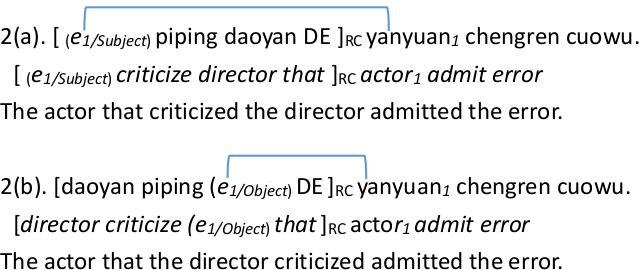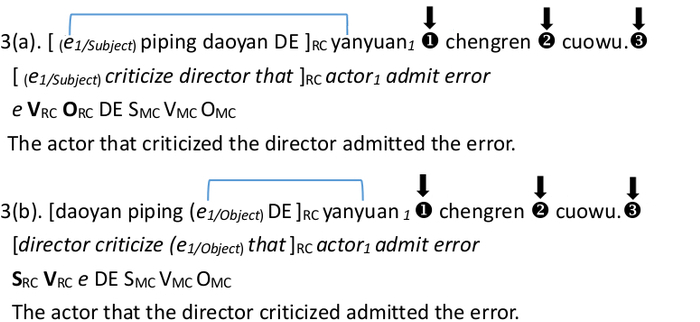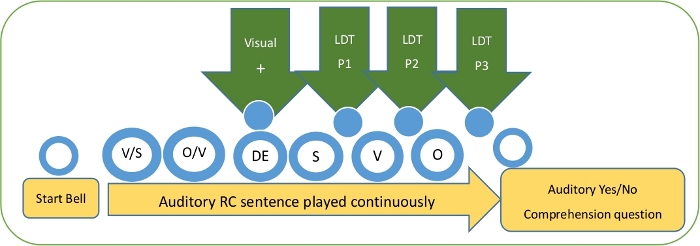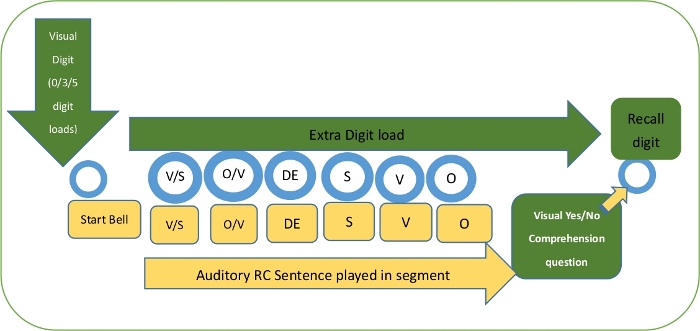Examining Online Syntactic Processing of Spoken Complex Sentences in Chinese Using Dual-Modal Interference Tasks
Summary
Here, we present a protocol employing dual-modal interference tasks to examine online processing of spoken-Chinese relative clause sentences. Two exemplar experiments involving auditory processing with intra- and extrasentential interferences are described. The paradigm provides a methodology for addressing the nature of working memory and its effects on sentence processing.
Abstract
Working memory (WM) plays a central role in the comprehension of complex sentences. Its function in the processing of spoken complex sentences is especially evident because spoken complex sentence processing is memory-intensive. The dual-modal interference paradigm has been used to examine how the WM system is involved in complex syntactic processing. This article presents two exemplar experiments involving auditory processing with either intra- or extrasentential interferences. In the first experiment, auditory stimuli [spoken-Chinese relative clause (RC) sentences with two syntactic types: subject-gapped (SRC) vs. object-gapped (ORC)] are interfered with via a visually presented lexical decision task within a sentence and manipulated using three different interference timepoints. In the second experiment, the same auditory stimuli, presented via an auditory window moving technique, are interfered with via a visually presented digital recall task beyond the sentence and manipulated using three digital memory loads. By assessing how the primary task of comprehending the RC sentences is affected by the secondary task, we can tackle the controversial issue concerning Chinese RC processing asymmetry. Our results reveal different patterns of RC processing compared to those reported in previous studies. Experiment 1 manifests no clear RC processing advantages in either SRC or ORC; however, a preference for ORC is observed at the ends of sentences, and a preference for SRC is found at the main verb site. Likewise, Experiment 2 presents a dynamic pattern. Under a no-digit load, SRCs show processing advantages in the RC marker region. However, under higher-digit-load interference, ORCs show processing advantages in the same region. These results lead to the conjecture that no obvious or intrinsic processing asymmetry exists in the processing of Chinese RCs. Using the approach of assessing specific interference during syntactic processing, these experiments demonstrate future research applications that explore the processing metrics of spoken sentences involving working memory.
Introduction
The role of working memory (WM) during spoken sentence processing is self-evident: due to the transient nature of speech, listeners must retain the component acoustic forms in their memories until they are processed. This aspect becomes even more important during processing of syntactically complex sentences. Assigning syntactic relations to words in complex sentences involves performing computational operations on items retained in memory for short periods of time, resulting in a higher memory demand. However, how the WM system is involved in spoken sentence processing is controversial.
This controversy involves two major disagreements: some researchers argue that a single WM system exists that is used for all verbal tasks1,2—in other words, syntactic processing relies on the same memory resources used by more general cognitive processes. This is the single-resource model. Others have claimed that determining the meaning of a sentence based on its syntactic structure involves a specialized WM system separate from that used for other verbal tasks3,4. In this vein, syntactic processing is modular. This is the separate-sentence-interpretation resource model.
In psycholinguistic research, the dual-modal interference paradigm has been used to examine the two competing accounts. Based on the assumption that WM storage capacity is limited5,6, the paradigm addresses issues by complicating a primary task with a secondary intervening task. Given that the primary task competes for limited resources with the secondary intervening task, the difficulty increases and the primary task exhibits longer reaction times. Given this situation, the dual-modal interference approach makes it possible to assess the processing load and extent of the WM’s involvement when a participant is given a task that requires fulfilling both tasks simultaneously.
Sentences containing RC components, which cause more comprehension difficulties due to their well-known complex syntactic structures, are widely used to investigate how the WM system is involved in processing complex sentences. However, although processing complex sentences places a higher demand on the WM resources associated with speech processing, it is less clear whether the WM that is thought to contribute to the costs of syntactic movements in languages with head-initial RC constructions (such as English) reflects the syntactic complexity of languages with head-final RCs (such as Chinese). Through the use of a dual-modal interference paradigm, the current study sheds light on this issue.
The difficulties associated with processing two RC structures, subject-gapped and object-gapped relative clauses (SRCs vs. ORCs), have been the subject of extensive debate. These controversies are mainly observed across typologically different languages. In head-initial languages such as English, in which a relative clause follows the head noun it modifies, the general finding is that SRCs such as in example 1(a) below are processed more easily than ORCs in example 1(b).

As shown in example (1), in English, the surface location of the gap differs minimally between SRCs and ORCs. This gap is indexed as e1, the empty position after the head noun ‘actor’ (called filler) left by its removal out of the RC. However, SRCs and ORCs differ substantially in terms of the grammatical structure and function of the gap in the RC domain. The memory cost for integrating and resolving the structural dependency between the filler and the gap is an apt target for experimental study and has been widely used to gain insights into the role of WM in language processing and comprehension.
For example, comprehending and processing these postnominal RCs requires indexing the head noun ‘actor’ as either a functional subject or the object of the verb ‘criticized’ in SRC and ORC and then storing the head noun in WM so it can later be assigned to the grammatical subject of the verb ‘admitted’ in the main clause.
In contrast to the consistent finding with head-initial languages that comprehending SRCs is easier than comprehending ORCs, mixed results have been reported regarding the RC processing asymmetry for Chinese, which is a head-final language in which a relative clause precedes the head noun. Some have observed an SRC processing advantage, while others have reported the opposite pattern (i.e., an ORC processing advantage). The latter lines of research also proposed that RC processing asymmetry can be modulated by WM, as suggested by results obtained from studies of self-paced reading performance7,8,9.
As mentioned above, there are two competing models regarding the role that WM plays in the (complex) syntactic processing. One is that “syntactic processing is modular”, and the other is that “syntactic processing is general”. Complex sentences with well-known differences in comprehension difficulty, i.e., SRCs vs. ORCs in English, are frequently used in dual-modal interference (DMI) tasks to examine these two assertions with respect to the question of modularity because the involvement of WM is claimed to parallel the processing asymmetry. Thus, inducing concurrent memory load through interfering tasks demonstrates WM effects on syntactic processing. The rationale is that whether a single verbal WM system or separate modular syntactic systems exist, engaging the system with an interfering task makes syntactic processing less efficient due to WM resource limitations. The way in which processing syntactically more complex sentences (ORC, in English) suffers in DMI tasks compares to processing syntactically simpler sentences (SRC, in English) provides evidence regarding the specific effect of WM and indicates the extent to which WM is involved.
In contrast to head-initial languages such as English, Chinese RCs manifests a head-final formation and exhibits a gap-filler relationship. The indexed moved-out element, the gap, precedes the head noun associating with it, as illustrated in 2(a), SRC, and 2(b), ORC.

The controversy that stems from processing Chinese RCs is that SRCs are not consistently reported as easier to process than ORCs, and this discrepancy has posed a challenge for theories of language processing and comprehension. Because the prenominal content before the relativizer ‘DE’ must be stored in WM until after the gap—the moved head noun ‘actor’, is linked and retrieved—understanding this process still helps in obtaining insights into the role of WM in language processing.
In the current study, spoken RC sentence processing is examined because listening is highly compressive during processing and is closely related to the functioning of WM. The dual modal interference paradigm is used because interference is a well-established forgetting function in short-term auditory memory. Representations stored in memory can be degraded and subsequently lost when interfering events occur10. Distractors that vary along different aspects (in the current case: intralinguistic and extradigital, see below) to the canonical spoken sentence allow us to measure the cost of integrating the incremental input during different processing phases and under differing interference conditions.
Based on the position that processing more syntactically complex sentences overloads WM more than does processing simpler sentences, one can hypothesize that manipulating the type of interference during the course of comprehension should have effects on sentence processing. By implication, processing syntactically more complex sentences will require either proportionately greater or disproportionately greater listening times online and show worse performance in postonline sentence comprehension assessment than will processing syntactically simpler constructions. The current study examines the hypothesis that interference during sentence processing can index WM involvement and virtually places its value beyond the issue of syntactic modularity: it proposes the idea that the controversy over Chinese RC processing can be elucidated through the investigation of WM due to its fundamental role in language comprehension. Therefore, the significance attached to the use of DMI tasks in Chinese RC processing provides a path to solving the ongoing debate concerning Chinese RC processing asymmetry.
This article presents two exemplar experiments involving auditory processing using both intra- and extrasentential interference. The goal of these two experiments was to explore to what extent WM is engaged in processing Chinese RC under differing types of interference.
In the first experiment, a visually presented lexical decision task was used as the intrasentential interference. As a secondary interfering task, the word/nonword lexical decision task (LDT) was introduced at three points during the auditory presentation of the target relative clause sentence, thus allowing the processing difficulty to be measured at these points. The major concern in this experiment is how the gap in the relative clause (RC) is associated with the filler in the matrix clause (MC) and whether it affects the processing of subsequent MC. Therefore, the three probing sites to be measured were set after the MC region. An example, replicated from (2), of the three probing sites indicated with arrows and aligned with corresponding syntactic concatenation, is illustrated in example 3, where 3(a) shows SRC and 3(b) shows ORC.

Figure 1 shows the procedure of interfering with the continuous auditory RC presentation by the LDT at any of the three probing sites. The timing design follows the conventional protocol of the LDT task in a previous Chinese processing study11. For example, each visual LDT trial begins with a cross sign “+” that indicates a fixation point in the center of the monitor for 500 ms, followed by the visual LDT stimulus, which is displayed on the screen for 3,000 ms and disappears immediately after the subject makes the lexical decision. A typical subject completes Experiment 1, including the practice session, within 30–35 minutes.

Figure 1: Intrasentential interference procedure with a lexical decision task.
Please click here to view a larger version of this figure.
The three probing sites along with the LDT task:
1. Position 1 (P1): Post-SMC region
The first position (P1) to be measured is immediately after the subject of the MC at the region after the RC boundary. Processing load is expected to incur at this site. For one thing, prior to this point (SMC), subject-gap and object-gap construction within the RC domain form contrastive verb-object (VO) and subject-verb (SV) structures, respectively. For another, to integrate the constituents in the RC region with the head noun in MC, listeners must identify the grammatical role of the gap and link it with the upcoming filler head noun
2. Position 2 (P2): Post-VMC region
The second position (P2) to be measured is immediately after the verb in the matrix clause (VMC). This site is also assumed to induce processing load. Integrating the verbal information requires listeners to retrieve the noun arguments in the sentence and to identify the agent of the matrix verb either from the preceding RC domain or from the head noun that the RC modifies.
3. Position 3 (P3): Postsentence region
The third position (P3) to be measured is immediately after the end of the sentence. Previous studies on processing propose that there is an end-of-sentence wrap-up effect—a phenomenon in which nonsyntactic information (e.g., discourse and semantic level) are considered at the end of a sentence to activate and complete comprehension12,13. Therefore, processing load should increase toward the end of the sentence due to the need to integrate this nonsyntactic information14,15. Position 3 is assumed to show a degradation in the processing load because sentence resolution has been attempted around this site.
In the second experiment, an auditory moving window (AMW) task was adopted. The AMW technique is considered to be able to capture patterns of resource allocation during online linguistic processing and has been widely used in attempts to distinguish between the two competing WM approaches16,17. It is presumed that extrasentential interference should cost listeners extra time during the course of processing the transient upcoming spoken sentence. Under the AMW paradigm, the participants heard sentences that were segmented into words, and they pressed a key on the keyboard to initiate playing of the subsequent segment. Thus, the durations of the pauses between keypresses to initiate the subsequent segment and control the flow of incoming information reflect the participants’ responsiveness to the particular linguistic features in question. For example, if the extrasentential interference has certain effects on processing sentences of differing syntactic complexity, participants will exhibit correspondingly longer pause durations before initiating the subsequent segments. The procedures are schematized and presented in Figure 2.

Figure 2: Extrasentential interference procedure with a digit recall task.
Please click here to view a larger version of this figure.
The following protocol shows how researchers use a visually presented lexical decision task as intrasentential interference and the concurrent arithmetic interference load as extrasentential interference to investigate WM involvement and the processing asymmetry of Chinese RCs and elaborate the underlying logic.
Protocol
Representative Results
Discussion
This study demonstrates that using DMI methods with both intra- and extrasentential interference tasks can help to elucidate the role of WM in spoken sentence processing and shed light on the issue of Chinese RC processing asymmetry. As expected, by measuring the extent to which interference from a secondary task affected listeners’ performances on primary sentence processing, we can infer the patterns of Chinese RC processing and arrive at a feasible solution to the debate on the Chinese SRC/ORC processing advanta…
Disclosures
The authors have nothing to disclose.
Acknowledgements
This study was supported by grants from the Ministry of Science and Technology, Taiwan, R.O.C. [NSC-101-2410-H-439-001] to the first author, Tuyuan Cheng. The authors thank lab members, Yang Ya-Hui and Chen Pei-Han, in NTIN, for their assistance in preparing and conducting the experiment.
Materials
| E-Prime | Psychology Software Tools | version Professional 2.0 | |
| Headphone | Logitech | ||
| Praat | Praat | 5.3.43 | The online software used to edit the sound files for listening; http://www.fon.hum.uva.nl/praat/ |
| Serial Response Box | Psychology Software Tools | ||
| Standard PC | ASUS K42Jv laptop |
References
- Just, M. A., Carpenter, P. A. A capacity theory of comprehension: Individual differences in working memory. Psychological Review. 99, 122-149 (1992).
- King, J., Just, M. A. Individual differences in syntactic processing: The role of working memory. Journal of Memory and Language. 30, 580-602 (1991).
- Caplan, D., Waters, G. S. Verbal working memory and sentence comprehension. Behavioral & Brain Sciences. 22, 77-94 (1999).
- Waters, G., Caplan, D., Yampolsky, S. On-line syntactic processing under concurrent memory load. Psychonomic Bulletin & Review. 10 (1), 88-95 (2003).
- Cowan, N. . Working Memory Capacity. , (2005).
- Miller, G. A. The magical number seven, plus or minus two: Some limits on our capacity for processing information. Psychological Review. 63, 81-97 (1956).
- Chen, B., Ning, A., Bi, H., Dunlap, S. Chinese subject-relative clauses are more difficult to process than the object-relative clauses. Acta Psychologica. 129, 61-65 (2008).
- Gibson, E., Wu, H. H. Processing Chinese relative clauses in context. Language and Cognitive Processes. 28, 125-155 (2013).
- Hsiao, F., Gibson, E. Processing relative clauses in Chinese. Cognition. 90, 3-27 (2003).
- Lewandowsky, S., Oberauer, K., Brown, G. D. A. No temporal decay in verbal short-term memory. Trends in Cognitive Science. 13, 120-126 (2009).
- Wu, J. T., Chou, T. L., Liu, I. M., Chang, H. W., Huang, J. T., Hue, C. W., Tzeng, O. J. L. The locus of the character/word frequency effect. Advances in the study of Chinese language processing. , 31-58 (1994).
- Fodor, J. D., Ni, W., Crain, S., Shankweiler, D. Tasks and timing in the perception of linguistic anomaly. Journal of Psycholinguistic Research. 25 (1), 25-57 (1996).
- Swinney, D., Zurif, E. Syntactic processing in aphasia. Brain and Language. 50 (2), 225-239 (1995).
- Balogh, J., Zurif, E., Prather, P., Swinney, D., Finkel, L. Gap-filling and end-of-sentence effects in real-time language processing: implications for modeling sentence comprehension in aphasia. Brain and Language. 61 (2), 169-182 (1998).
- Granier, J. P., Robin, D. A., Shapiro, L. P., Peach, R. K., Zimba, L. D. Measuring processing load during sentence comprehension: visuomotor tracking. Aphasiology. 14 (5-6), 501-513 (2000).
- Waters, G. S., Caplan, D. Age, working memory, and on-line syntactic processing in sentence comprehension. Psychology and Aging. 16, 128-144 (2001).
- Waters, G. S., Caplan, D. Working memory and online syntactic processing in Alzheimer’s disease: Studies with auditory moving window presentation. Journal of Gerontology: Psychological Sciences. 57B, 298-311 (2002).
- Cheng, T., Cheung, H., Wu, J. Spoken relative clause processing in Chinese: measure from an alternative task. Language and Linguistics. 12 (3), 669-705 (2011).
- Cheng, T., Wu, J., Huang, S. Use of Memory-Load Interference in Processing Spoken Chinese Relative Clauses. Journal of Psycholinguistic Research. 47 (5), 1035-1055 (2018).
- CKIP. . Zhongwen shumianyu pinlü cidian [Dictionary of Chinese written word frequency], CKIP Technical Report, No. 94-01. , (1994).
- MacWhinney, B., James, J., Schunn, C., Li, P., Schneider, W. Step—A system for teaching experimental psychology using E-Prime. Behavior Research Methods, Instruments, and Computers. 33 (2), 287-296 (2001).
- Ferreira, F., Henderson, J., Anes, M., Weeks, P., McFarlane, D. Effects of lexical frequency and syntactic complexity in spoken language comprehension: Evidence from the auditory moving-window technique. Journal of Experimental Psychology: Learning, Memory, and Cognition. 22, 324-335 (1996).
- Daneman, M., Carpenter, P. A. Individual differences in working memory and reading. Journal of Verbal Learning and Verbal Behavior. 19, 450-466 (1980).
- Bulut, T., Cheng, S. K., Xu, K. Y., Hung, D. L., Wu, D. H. Is there a processing preference for object relative clauses in Chinese? Evidence from ERPs. Frontiers in Psychology. 9, 1-18 (2018).
- Mitchell, D. C., Green, D. W. The effects of context and content on immediate processing in reading. Quarterly Journal of Experimental Psychology. 30 (4), 609-636 (1978).

